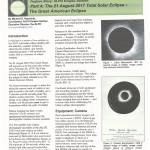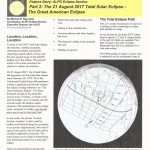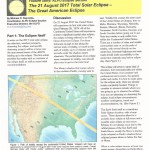August 31, 2010
Timing an Eclipse of the Moon with the Unaided Eye
John E. Westfall, ALPO Science Editor
P.O. Box 2447, Antioch, CA 94531-2447; johnwestfall@comcast.net
In map-making and navigation it is essential to be able to find one’s latitude and longitude. With GPS we now find these coordinates with ease. We thus may forget that, prior to the invention of the telescope, the only practical way to find longitude involved two observers at different places noting the local time of the phases of eclipses of the Moon. The difference of time between the two locations gave their longitude difference.
This procedure provided the only longitudes measured in ancient and medieval times. The results were not very accurate. Part of the error undoubtedly was due to the imprecision of timing events by “hours of the night.” But some of the error was also attributable to the naked-eye timing of the events.
Naked-eye timings of the phases of a lunar eclipse are rarely done these days, so there are few published data on their accuracy. For this reason, the writer invites observers to time, without telescope or binoculars, the four umbral contacts of the total lunar eclipse of December 21, 2010.*
Although the timings must be made without optical aid, this doesn’t mean you can’t observe most of the eclipse through binoculars or a telescope. However, to avoid any possible bias in the timings made with your unaided eyes, we recommend the following:
Beginning 10 minutes before the predicted time of an eclipse contact, view the Moon with the naked eye only. Also, during this period do not look at a timepiece or listen to time signals until the instant that you believe the eclipse contact has occurred. Then note that time to 0.1-minute precision. You can now resume viewing through binoculars or a telescope.
We hope that some observers will be interested in this minimal-technology way to observe an eclipse of the Moon. When the event is over, please send your results to the writer at the address above. Be sure to note any circumstances, such as clouds or haze, which may have affected your results.
* The predicted Universal Times of the four umbral contacts on December 21 are:
06h 32m First Contact; the dark umbral shadow first touches the Moon
07h 40m Second Contact; the Moon is now completely within the umbra
08h 54m Third Contact; the umbra begins to leave the Moon
10h 02m Fourth Contact; the Moon is now completely outside the umbra
At least one of these events should be visible throughout North and Central America as well as Hawaii.







